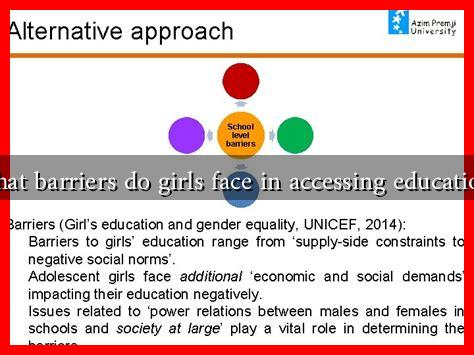-
Table of Contents
What Barriers Do Girls Face in Accessing Education?
Education is a fundamental human right and a powerful tool for personal and societal development. However, millions of girls around the world face significant barriers that hinder their access to education. These obstacles are multifaceted, ranging from socio-economic factors to cultural norms. Understanding these barriers is crucial for creating effective strategies to promote gender equality in education.
Socio-Economic Barriers
One of the most significant barriers to girls’ education is socio-economic status. Families with limited financial resources often prioritize education for boys over girls due to traditional beliefs and economic pressures. This disparity is evident in various regions, particularly in low-income countries.
- Cost of Education: School fees, uniforms, and supplies can be prohibitively expensive for low-income families. In many cases, families may choose to invest in the education of their sons, viewing it as a more valuable investment.
- Child Labor: In some cultures, girls are expected to contribute to household income through work. This often leads to girls dropping out of school to take on domestic responsibilities or paid labor.
- Poverty Cycle: Lack of education perpetuates the cycle of poverty. Girls who do not receive an education are more likely to remain in low-paying jobs, which affects their families and communities.
Cultural and Social Norms
Cultural attitudes towards gender roles significantly impact girls’ access to education. In many societies, traditional beliefs dictate that girls should focus on domestic duties rather than pursuing academic goals.
- Early Marriage: In some cultures, girls are married off at a young age, often before they complete their education. According to UNICEF, approximately 12 million girls are married before the age of 18 each year, which severely limits their educational opportunities.
- Gender Discrimination: In many regions, girls face discrimination in educational settings, including biased teaching practices and a lack of female role models. This can discourage girls from pursuing their education.
- Safety Concerns: In some areas, the journey to school can be dangerous for girls due to harassment or violence. This fear can deter families from sending their daughters to school.
Geographical Barriers
Geographical location plays a crucial role in educational access. In rural areas, the lack of schools and educational resources can be a significant barrier for girls.
- Distance to Schools: In many rural communities, schools are located far from home, making it difficult for girls to attend regularly. This is particularly problematic in regions where transportation is limited.
- Inadequate Infrastructure: Many schools in rural areas lack basic facilities such as clean water, sanitation, and safe learning environments, which can discourage attendance.
- Natural Disasters: Areas prone to natural disasters may see schools destroyed or rendered inaccessible, disproportionately affecting girls who may already be facing barriers to education.
Case Studies and Statistics
Several organizations are working to address these barriers and promote girls’ education. For instance, the Global Partnership for Education (GPE) has invested over $5 billion in education programs, with a focus on gender equality. According to their reports, countries that prioritize girls’ education see significant improvements in economic growth and community health.
Statistics reveal the stark reality of girls’ education globally:
- According to UNESCO, 130 million girls worldwide are out of school.
- Girls are 1.5 times more likely to be out of school than boys in low-income countries.
- Every additional year of schooling for girls can increase their future earnings by up to 20%.
Conclusion
The barriers that girls face in accessing education are complex and deeply rooted in socio-economic, cultural, and geographical factors. Addressing these challenges requires a multifaceted approach that includes policy changes, community engagement, and international support. By investing in girls’ education, we not only empower individuals but also foster healthier, more prosperous communities. It is imperative that governments, NGOs, and society as a whole work together to dismantle these barriers and ensure that every girl has the opportunity to learn and thrive.
For more information on initiatives aimed at promoting girls’ education, visit UNICEF’s Girls’ Education page.


